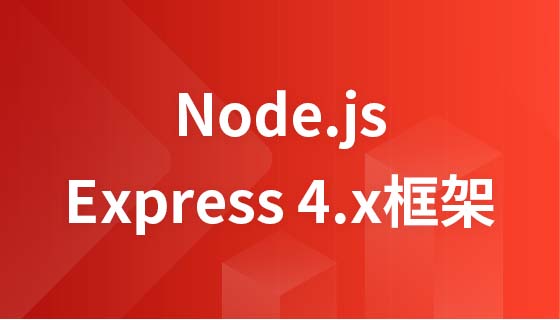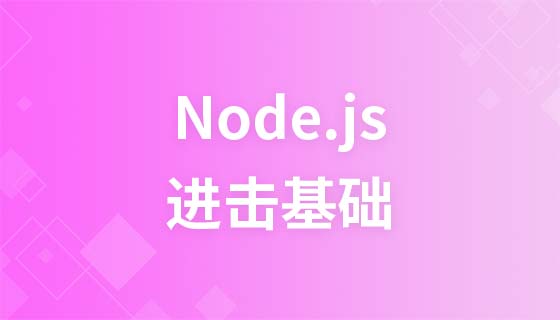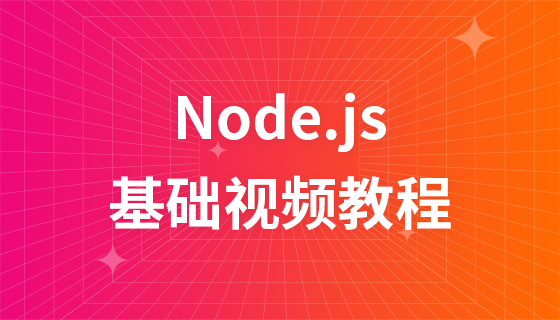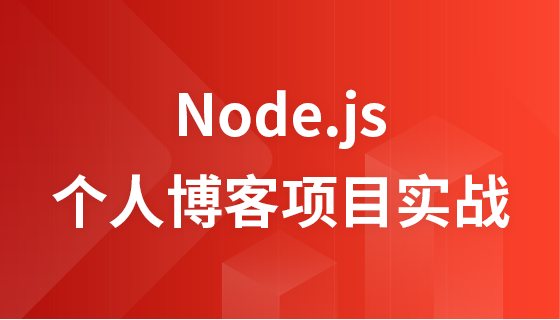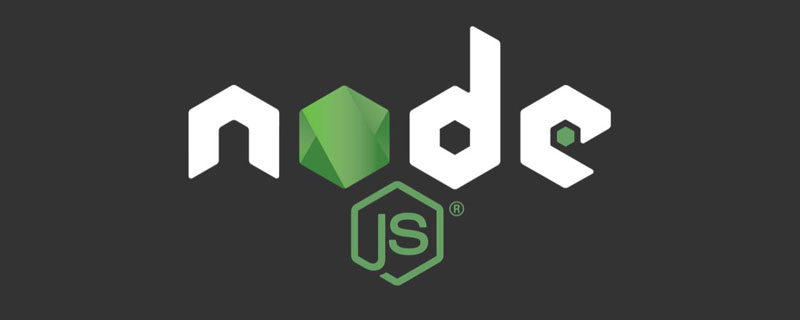
Node.js 對初學者來說可能是令人望而卻步的,其靈活的結構和缺乏嚴格的規範使它看起來很複雜。 【影片教學推薦:node js教學 】
本教學是 Node.js,Express 框架和 MongoDB 的快速指南,重點介紹基本的 REST 路由和基本的資料庫互動。你將建立一個簡單的 API 框架模版,然後可以將其用作任何應用。
本教學適用於:你應該對 REST API 和 CRUD 操作有基本的了解,還有基本的 JavaScript 知識。我用的是 ES6(主要是箭頭函數),但不是很複雜。
在本教程中,我們將為創建一個網頁筆記應用的後端骨架—— 類似於Google Keep,能夠執行所有的四個CRUD操作:建立、讀取、更新和刪除。
如果你沒有安裝Node,請參考這裡。
建立一個新目錄,執行 npm init,然後按照提示操作,把你的應用程式命名為「notable」(或你可能喜歡的其他名字)。
npm init
一旦完成,在你的目錄中會有一個 package.json 檔案。你可以開始安裝專案所需的依賴項了。
我們將使用 Express 作為自己的框架,MongoDB 作為資料庫,還有一個名為 body-parser 的套件來幫助處理 JSON 請求。
npm install --save express mongodb@2.2.16 body-parser
我還強烈建議將 Nodemon 安裝為 dev 依賴項。這是一個非常簡單的小包,可在檔案更改時自動重新啟動伺服器。
如果你執行:
npm install --save-dev nodemon
然後將以下腳本加入到package.json:
// package.json
"scripts": {
"dev": "nodemon server.js"
},完整的package.json 應如下所示:
// package.json
{
"name": "notable",
"version": "1.0.0",
"description": "",
"main": "server.js",
"scripts": {
"dev": "nodemon server.js"
},
"author": "",
"license": "ISC",
"dependencies": {
"body-parser": "^1.15.2",
"express": "^4.14.0",
"mongodb": "^2.2.16"
},
"devDependencies": {
"nodemon": "^1.11.0"
}
}現在,你可以建立server.js 檔案並建立API 了。
首先導入 server.js 中的所有相依性。
// server.js const express = require('express'); const MongoClient = require('mongodb').MongoClient; const bodyParser = require('body-parser'); const app = express();
我們將使用 MongoClient 與資料庫互動。也會將應用程式初始化為 Express 框架的實例。
最後一件事就是告訴你的程式開始監聽請求。
你可以指定一個端口,並像這樣開始監聽:
// server.js
const port = 8000;
app.listen(port, () => {
console.log('We are live on ' + port);
});現在,如果你執行npm run dev(或node server.js,如果你沒有安裝Nodemon 的話),你應該在終端機中看到「We are live on port 8000」的提示。
你的伺服器已經啟動了。但它現在還什麼也做不了。
接下來讓我們解決這個問題。
對於本例,你要建立4條路由; 建立筆記,閱讀筆記,更新筆記和刪除筆記。
這將使你了解如何使用 Node 建立幾乎所有的基本路由。
但是,要測試你的API,還需要模仿客戶端發出請求。為此,我們將使用名為 Postman 的優秀應用程式。它允許你使用自訂的頭和參數進行簡單的 HTTP 請求。
安裝Postman,讓我們開始設定路由。
大多數 Node.js 教學(以及許多真實的案例)都將所有路由放在一個很大的 routes.js 檔案中。這讓我有點不舒服。相較之下,將檔案拆成單獨的資料夾可以提高可讀性,並使大型應用程式更易於管理。
雖然我們現在做的不是大型應用,但仍然可以這樣做。建立以下目錄:一個 app 資料夾,裡面有一個routes資料夾,routes 裡面有 index.js 和 note_routes.js 檔案。
mkdir app cd app mkdir routes cd routes touch index.js touch note_routes.js
對於你的簡單小程式來說,這些目錄可能看起來有些過分,但從一開始就做好總是有意義的。
讓我們從 CRUD 中的 C 開始。你將會如何建立一個筆記?
那麼,在你開始之前,必須先打好基礎。在Express中,路由包含在一個函數中,該函數將 Express 實例和資料庫作為參數。
像這樣:
// routes/note_routes.js
module.exports = function(app, db) {
};然後,你可以透過index.js# 匯出此函數:
// routes/index.js
const noteRoutes = require('./note_routes');
module.exports = function(app, db) {
noteRoutes(app, db);
// Other route groups could go here, in the future
};然後匯入它以便在server .js 中使用:
// server.js
const express = require('express');
const MongoClient = require('mongodb').MongoClient;
const bodyParser = require('body-parser');
const app = express();
const port = 8000;
require('./app/routes')(app, {});
app.listen(port, () => {
console.log('We are live on ' + port);
});請注意,由於還沒有設定資料庫,因此只需傳入一個空物件。
好的,現在你可以製作自己的 CREATE 路由了。
語法很簡單:
// note_routes.js
module.exports = function(app, db) {
app.post('/notes', (req, res) => {
// You'll create your note here.
res.send('Hello')
});
};當應用程式收到對'/ notes' 路徑的post 請求時,它將執行回調內的程式碼- request 對象(包含請求的參數或JSON)和response 物件。
你可以使用 Postman 將 POST 請求傳送到 localhost:8000/notes 來測試。

你应该得到回复:'Hello'。
太好了!你创建了第一个真正的路由。
下一步是在你的请求中添加一些参数并在 API 中处理它们,最后添加到你的数据库中。
在 Postman 中,在选择 x-www-form-urlencoded 单选按钮后,转到 Body 选项卡并添加一些键值对。
这会将编码后的表单数据添加到你的请求中,你可以使用 API ??处理该请求。
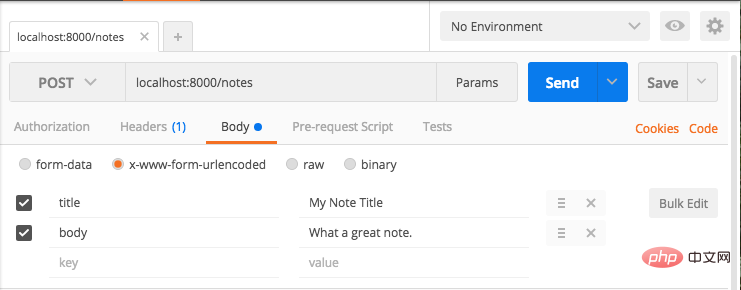
你可以去尝试更多的设置项。
现在在你的 note_routes.js 中,让我们输出 body 的内容。
// note_routes.js
module.exports = function(app, db) {
app.post('/notes', (req, res) => {
console.log(req.body)
res.send('Hello')
});
};用 Postman 发送请求,你会看到……undefined。
不幸的是,Express 无法自行处理 URL 编码的表单。虽然你确实安装了这个 body-parser 包......
// server.
const express = require('express');
const MongoClient = require('mongodb').MongoClient;
const bodyParser = require('body-parser');
const app = express();
const port = 8000;
app.use(bodyParser.urlencoded({ extended: true }));
require('./app/routes')(app, {});
app.listen(port, () => {
console.log('We are live on ' + port);
});Now you should see the body as an object in the terminal.
现在你应该将 body 视为终端中的对象。
{ title: 'My Note Title', body: 'What a great note.' }第一个路由的最后一步:设置数据库,然后添加数据。
最简单方法是通过 mLab 设置 Mongo 数据库的:它是最小的而且是免费的,设置的速度非常快。
创建帐户和 MongoDB 部署后,将用户的用户名和密码添加到数据库:

然后复制这里第二个 URL:

在项目根目录的目录配置中,创建一个db.js文件。
mkdir config cd config touch db.js
在里面,添加刚才的URL:
module.exports = {
url : YOUR URL HERE
};别忘了把你的用户名和密码(来自数据库用户的密码,而不是你的 mLab 帐户)添加到URL中。 (如果你要将此项目提交到 Github 上,请确保包含 .gitignore 文件 像这样, ,不要与任何人分享你的密码。)
现在在你的 server.js 中,可以用 MongoClient 连接到数据库了,使用它来包装你的应用程序设置:
// server.js
const express = require('express');
const MongoClient = require('mongodb').MongoClient;
const bodyParser = require('body-parser');
const db = require('./config/db');
const app = express();
const port = 8000;
app.use(bodyParser.urlencoded({ extended: true }));
MongoClient.connect(db.url, (err, database) => {
if (err) return console.log(err)
require('./app/routes')(app, database);
app.listen(port, () => {
console.log('We are live on ' + port);
});
})如果你用的是最新版本的 MongoDB(3.0+),请将其修改为:
// server.js
const express = require('express');
const MongoClient = require('mongodb').MongoClient;
const bodyParser = require('body-parser');
const db = require('./config/db');
const app = express();
const port = 8000;
app.use(bodyParser.urlencoded({ extended: true }));
MongoClient.connect(db.url, (err, database) => {
if (err) return console.log(err)
// Make sure you add the database name and not the collection name
const database = database.db("note-api")
require('./app/routes')(app, database);
app.listen(port, () => {
console.log('We are live on ' + port);
});
})这是你的基础架构的最后一个设置!
MongoDB将数据存储在 collections 中。在你的项目中,你希望将笔记存储在一个名为 notes 的 collection 中。
由于将数据库作为路径中的 db 参数传入,因此可以像这样访问它:
db.collection('notes')
创建笔记就像在集合上调用 insert 一样简单:
const note = { text: req.body.body, title: req.body.title}
db.collection('notes').insert(note, (err, results) => {
}插入完成后(或由于某种原因失败),要么返回错误或反回新创建的笔记对象。这是完整的 note_routes.js 代码:
// note_routes.js
module.exports = function(app, db) {
const collection =
app.post('/notes', (req, res) => {
const note = { text: req.body.body, title: req.body.title };
db.collection('notes').insert(note, (err, result) => {
if (err) {
res.send({ 'error': 'An error has occurred' });
} else {
res.send(result.ops[0]);
}
});
});
};试试看!使用 Postman 发送 x-www-form-urlencoded POST 请求,在 Body 选项卡下设置 title 和 body。
响应应如下所示:

如果你登录mLab,你还应该能够在数据库中看到创建的笔记。
现在可以稍微加快步伐。
假设你希望通过导航到 localhost:8000/notes/{id} 来获取刚创建的笔记。这是链接应该是localhost:8000/notes/585182bd42ac5b07a9755ea3。(如果你没有得到其中笔记的 ID,可以通过检查 mLab 或创建一个新的笔记)。
以下是 note_routes.js 中的内容:
// note_routes.js
module.exports = function(app, db) {
app.get('/notes/:id', (req, res) => {
});
app.post('/notes', (req, res) => {
const note = { text: req.body.body, title: req.body.title };
db.collection('notes').insert(note, (err, result) => {
if (err) {
res.send({ 'error': 'An error has occurred' });
} else {
res.send(result.ops[0]);
}
});
});
};就像以前一样,你将在数据库 collection 中调用一个方法。在这里,它被恰当地命名为 findOne。
// note_routes.js
module.exports = function(app, db) {
app.get('/notes/:id', (req, res) => {
const details = { '_id': <ID GOES HERE> };
db.collection('notes').findOne(details, (err, item) => {
if (err) {
res.send({'error':'An error has occurred'});
} else {
res.send(item);
}
});
});
app.post('/notes', (req, res) => {
const note = { text: req.body.body, title: req.body.title };
db.collection('notes').insert(note, (err, result) => {
if (err) {
res.send({ 'error': 'An error has occurred' });
} else {
res.send(result.ops[0]);
}
});
});
};你可以通过 req.params.id 从 URL 参数中获取 id。但是,如果你试图将字符串插入上面的 <ID GOES HERE> 位置,它将无法正常工作。
MongoDB 不仅要求 ID 为字符串,还要求 ID 是一个对象,它们被之为 ObjectID。
别担心,这很容易解决。这是完整的代码:
// note_routes.js
var ObjectID = require('mongodb').ObjectID;
module.exports = function(app, db) {
app.get('/notes/:id', (req, res) => {
const id = req.params.id;
const details = { '_id': new ObjectID(id) };
db.collection('notes').findOne(details, (err, item) => {
if (err) {
res.send({'error':'An error has occurred'});
} else {
res.send(item);
}
});
});
app.post('/notes', (req, res) => {
const note = { text: req.body.body, title: req.body.title };
db.collection('notes').insert(note, (err, result) => {
if (err) {
res.send({ 'error': 'An error has occurred' });
} else {
res.send(result.ops[0]);
}
});
});
};尝试使用一个笔记 ID,它应如下所示:

实际上删除对象与查找对象几乎相同。你只需用 remove 函数替换 findOne 即可。这是完整的代码:
// note_routes.js
// ...
app.delete('/notes/:id', (req, res) => {
const id = req.params.id;
const details = { '_id': new ObjectID(id) };
db.collection('notes').remove(details, (err, item) => {
if (err) {
res.send({'error':'An error has occurred'});
} else {
res.send('Note ' + id + ' deleted!');
}
});
});
// ...最后一个! PUT 方法基本上是 READ 和 CREATE 的混合体。你找到该对象,然后更新它。如果刚才你删除了数据库中唯一的笔记,那就再创建一个!
代码:
// note_routes.js
// ...
app.put('/notes/:id', (req, res) => {
const id = req.params.id;
const details = { '_id': new ObjectID(id) };
const note = { text: req.body.body, title: req.body.title };
db.collection('notes').update(details, note, (err, result) => {
if (err) {
res.send({'error':'An error has occurred'});
} else {
res.send(note);
}
});
});
// ...现在你可以更新任何笔记,如下所示:
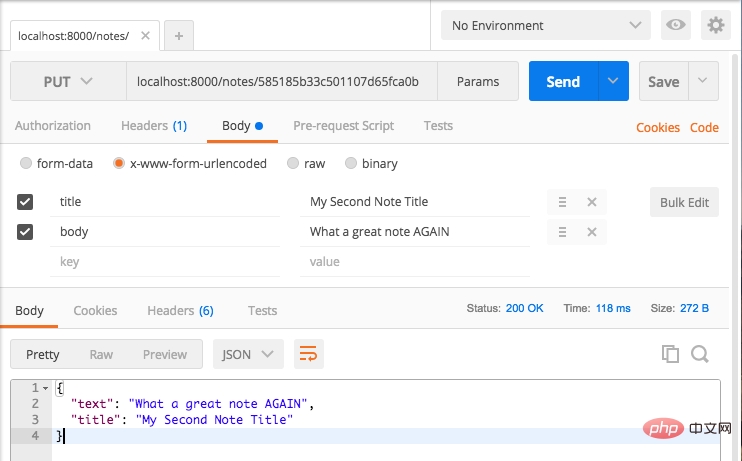
请注意这些代码还不完美 —— 比如你没有提供正文或标题,PUT 请求将会使数据库中的笔记上的那些字段无效。
就这么简单!你完成了可以进行 CRUD 操作的 Node API。
本教程的目的是让你熟悉 Express、Node 和 MongoDB —— 你可以用简单的程序作为进军更复杂项目的跳板。
将来我将会编写系列教程,用不同的语言和框架创建更简单的API。如果你有兴趣,请点击关注!
更多编程相关知识,可访问:编程教学!!
以上是用Node.js如何快速建構一個API伺服器?的詳細內容。更多資訊請關注PHP中文網其他相關文章!

